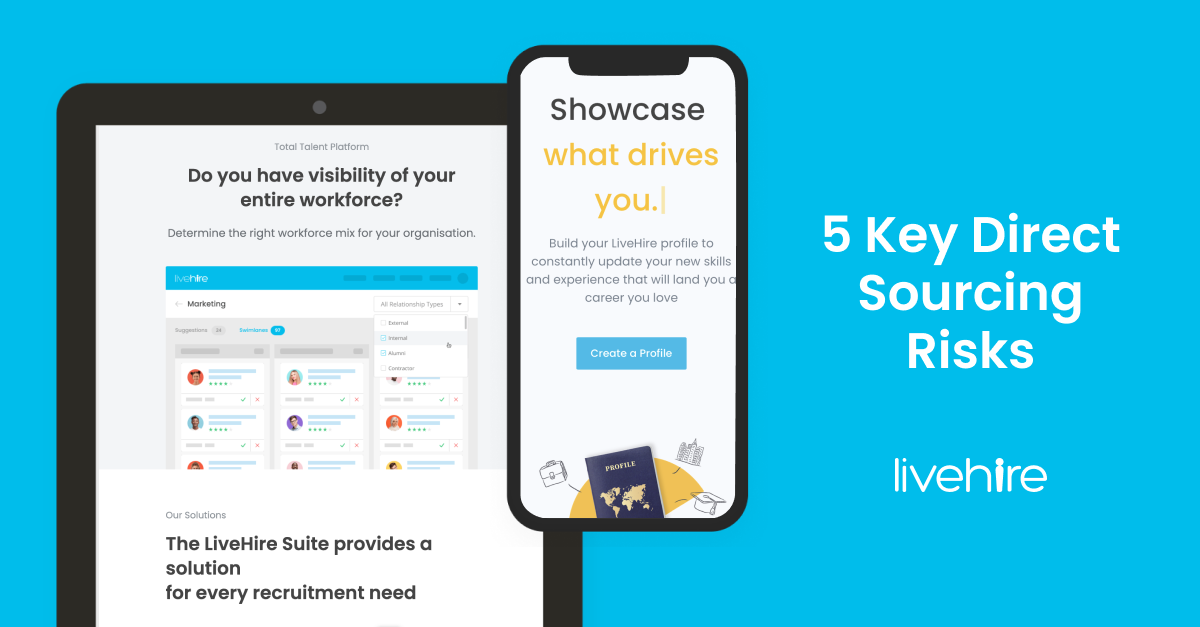
In the pandemic aftermath, senior leaders are more focused on delivering workforce agility than ever before. Meanwhile, the latest data from Ardent Partners indicates that a growing percentage (46.5%) of the US workforce is considered ‘non-employee’.
In response, the war for contingent talent is reaching new heights. Many contingent staffing leaders today believe a direct sourcing revolution is under way. With contingent workforce leaders increasingly turning to direct sourcing for a competitive edge, one big question is surfacing… What is the difference between those that achieve direct sourcing success versus those that don’t? In fact, research indicates direct sourcing leaders outperform laggards by a staggering factor of 4:1 across all key metrics.
Do leaders and laggards have different types of challenges? Probably not. Are these leaders just better at their jobs? Also, probably not. So, what sets these two groups so far apart? The answer typically lies in their level of experience, capability and commitment to embedding direct sourcing practices. To that end, the SIA 2021 Direct Sourcing report finds 58% of the leaders outsource the overall process to a Managed Direct Sourcing (MDS) supplier.
According to the latest research, if you’ve landed here, you likely fall into one of three categories:
- You are among the 60% of buyers planning to explore direct sourcing above other workforce strategies in the next couple of years;
- You are among the majority of early adopters who don’t believe their direct sourcing practices are leading edge and are searching for ways to optimize their efforts; or
- You are the curious onlooker interested in better understanding the true business case for this new wave of Direct Sourcing technology uptake.
Top strategic priorities for contingent workforce leaders in 2021
Regardless of where you are at in your exploration of direct sourcing, this guide will provide you with the latest information you’ll need to consider to optimize results with direct sourcing providers. When considering direct sourcing vendors, it’s important to ensure alignment with your strategic goals and clearly defined criteria. To prepare you for this, a sound understanding of managed direct sourcing, the vendor universe, key implementation risks and program ownership are paramount. In this guide, we’ll set you up for ultimate direct sourcing partnership success, by covering the following 10 key direct sourcing questions:
1. What is Managed Direct Sourcing?
‘Direct Sourcing’ is when a company leverages its employer brand to attract and engage a pipeline of qualified contractors, resulting in substantial cost savings, an improved experience for your candidates and better quality talent. Rather than running the direct sourcing program in-house, many companies choose to work with a series of outsourced partners to curate their private Talent Pools and provide MSP and payroll services (hence, “managed” direct sourcing).
2. Why invest in a Managed Direct Sourcing solution?
The contingent workforce makes up a substantial portion of the US workforce today and Gartner anticipates continued growth over the next few years. With rising demands for talent, agility and cost savings, contingent workers present a vital solution for tomorrow’s global economy. Moreover, 77% of global talent and procurement leaders are more focused on workforce agility than ever before. With this in mind and the promise of managed direct sourcing offering just that, learn more about the business case for investing in a managed direct sourcing solution.
3. What’s the difference between Direct Sourcing technology and Vendor Management Systems?
Both Vendor Managements Systems (VMS) and Direct Sourcing technology play an integral part in delivering Direct Sourcing outcomes, but there is often confusion surrounding why you need both and the specific role each plays. The role of the vendor management system is to be the ‘system of record’ within your contingent workforce program. That said, there are inherent trade-offs between large ‘systems of record’ and the type of user experience we’ve all come to expect from consumer technology. Industry thought leader Josh Bersin has written extensively on the topic of HR technology and the gradual migration from ‘systems of record’ to systems of engagement and experience. Similar to a HR system of record that maintains employee information, the introduction of VMS technology continues to play a critical role for advanced back office compliance and efficiency. While many VMS technologies continue to evolve and improve, they are often lacking in features that enable a consumer-like experience. That brings us to Direct Sourcing, which includes 7 key features that are critical to success, including advanced talent pooling and 2-way text message engagement.
4. What are the main risks to consider when implementing a Direct Sourcing program?
Given Direct Sourcing is in the early adoption phase, there is no hard and fast risk mitigation roadmap. Before implementing a Direct Sourcing program from scratch, it is vital that organizations are armed with the necessary knowledge for navigating the major risks and compliance issues.
- Candidate experience and brand impact
- Co-employment and independent contractor misclassification
- Data privacy
- Discrimination
- Change management and communication
Implementing a Direct Sourcing program entails a number of risks that, when considered carefully from the outset, can be well mitigated. Further, with the right partner ecosystem, you can collaborate with existing industry specialists who already know how to manage all of these risks and can help you maximize the benefits of your successful Direct Sourcing program.
5. Who are all the key vendors involved in delivering a Direct Sourcing solution?
Direct Sourcing is rarely delivered with internal resources. Typically, it is done with suppliers leveraged through outsourced programs. This is made up of an ecosystem of specialized solution providers, enabling optimized programs across the globe.
- Staffing partner
- Payroll partner (sometimes the same as your staffing partner)
- Managed Service Provider (MSP)
- Vendor Management System (VMS)
- Direct Sourcing Technology partner
Here’s how it works. The Direct Sourcing technology partner builds a branded Talent Cloud to attract and engage contingent workers. Your preferred staffing partner manages and curates your Talent Cloud to create role-specific Talent Pools for rapid sourcing at a reduced rate. The staffing partner may also offer payrolling services and act as the employer of record, or that role may be performed by another provider. Meanwhile, your MSP and VMS continue to operate in their existing roles to oversee the entire contingent workforce program.
6. How can you leverage Direct Sourcing to reduce your time-to-hire for contingent staff?
The best talent is always in high demand. We all know this, but do we plan accordingly for it in our processes? Contractors are often high-quality specialists with proven skills, as they must frequently demonstrate their capabilities off the back of their reputation and most recent project. Typically, they become highly effective at moving from contract to contract, commonly with their next jobs lined up. With this in mind, it is paramount that lengthy, drawn-out recruitment processes are eliminated for contingent workers so as not to risk losing them to a competitor. There are 5 essential ways Direct Sourcing will accelerate contingent hiring from point of application to accepting a job offer at your organization:
- Seamless candidate experience
- Having a structured recruitment process
- By nurturing a Talent Cloud of qualified contingent candidates
- Rapid communication
- Running the whole process on a digital staffing platform
Having a fast time-to-hire for contingent labor is not a cherry on top, it’s a prerequisite to remaining competitive in the private sector and delivering effective customer service in the public sector. While there are multiple levers you can pull from the moment a candidate applies to the point they accept, the key is having clear communication, a robust and structured process and ensuring all stakeholders are aligned.
7. How can Direct Sourcing improve the quality of your contingent hires?
Key to improving the quality of your hires is ensuring a synergistic relationship between the contingent hire, the role and the employer. How is this best achieved? By authentically leveraging your employer brand. Sounds simple enough. The tricky part is that not many Procurement leaders have thought about employer brand, influenced employer brand or know where to get the information about their brand at speed. This is why collaboration between Procurement and HR is of paramount importance in Direct Sourcing today.
With contingent workers rapidly rising as a percentage of the overall global workforce, Direct Sourcing offers an effective means of ensuring you continue to manage and drive the quality of this segment of your workforce. Leveraging your employer brand, evolving your employee value proposition (EVP) to create a contractor value proposition (CVP) and keeping a keen eye on how diversity hiring is being considered for contractors will be key components to your success.
8. How can you deliver a positive candidate experience for your contingent workforce?
Traditionally, contingent workers have been engaged via third party staffing providers. With this traditional method of contingent recruitment, it has left third party staffing suppliers as the responsible party for promoting the employer brand to source and attract qualified talent. Without a consistent approach to employer branding, candidates can be left with a negative experience from the third party staffing providers.
Developing a branded Talent Cloud for contingent hires or working with your third party staffing provider to build a Talent Cloud that is consistent with your employer brand is key to attracting and retaining top talent across the permanent and contingent workforce.
Effectively managing your Talent Cloud allows you to engage with more contractors who are aligned with upcoming roles, know your brand and will be eager to apply. In fact, using LiveHire benchmarks, there are a range of significant results you will obtain from effectively leveraging your Talent Pools for contingent hires:
- Faster responses: 17 minutes median candidate response time to text message invitations
- Higher conversion rate: When hiring from the Talent Cloud, organizations only need three shortlisted candidates to get a successful hire. By comparison, you would need 15 shortlisted candidates from traditional job ad sources to find a successful candidate.
- Better diversity outcomes: A more inclusive and engaging hiring experience allows LiveHire clients to achieve 15% better gender diversity outcomes than their industry peers.
- Text message communication is perfect for rapid, single or bulk communication and is the preferred experience for quality talent
- Higher percentage of candidates in your Talent Cloud say ‘yes’ to joining a shortlist on demand
Unlike email, personalised, timely, and relevant texts are not perceived as spam.
9. Who ‘owns’ contingent workforce programs and why?
There are many complexities that accompany the running of a successful contingent workforce program (CWP) ranging across legal, compliance, supplier engagement and program innovations. This begs a vital question, who currently owns the CWP in your organization? Moreover, who should own your program as it evolves and why?
As the department most in tune with contract negotiations and vendor management, Procurement initially took the lead on CWP ownership.
By sitting within Procurement, ownership of contingent workforce programs remains with the department who has expertise in obtaining competitive arrangements with recruitment agencies, payroll providers, Managed Service Providers (MSPs) and Vendor Management System (VMS) providers. For these reasons, Procurement was initially at the forefront of CWP ownership.
However, with the rapid rise in contingent workers, the nature of contingent workforce programs has evolved considerably to include more candidate attraction and engagement, employer branding and further alignment with diversity, equity, and inclusion goals. This indicates that greater involvement from HR would contribute to CWP success. In fact, this shift in ownership is currently being seen in businesses globally.
10. What are some of the common myths behind Direct Sourcing?
There’s a number of myths around direct sourcing that might deter you from looking into it as a solution for your organization. We dug into the top myths around direct sourcing to help you find out if it really is the cost effective process for your organization to explore.
- Many companies believe they are already doing some form of direct sourcing, but in reality, a very small percentage of the Fortune 1000 companies are effectively leveraging their brands to attract contingent candidates.
- It’s a common misconception that direct sourcing can’t ever be more than a ‘side-hustle’ to the traditional supplier base.
- Some companies believe their internal recruitment team is best placed to run their contingent direct sourcing program, but this is rarely the case.
- There is a belief that a company’s permanent recruitment software can be repurposed as a direct sourcing platform. In fact, many permanent recruitment platforms are ill-suited to modern, fast-paced candidate engagement and recruitment.
- Finally, some contingent workforce leaders are concerned about the time and cost of implementing a direct sourcing strategy. In reality, standing up a direct sourcing solution can be accomplished within short timeframes and can quickly lead to significant cost savings.
The Takeaway
Building upon a deeper foundational understanding of the world of direct sourcing provided in this guide, what is the secret source for optimizing your chosen direct sourcing partnerships? Knowing your context.
Using the 10 questions highlighted in this guide as your point of reference, you are now well placed to begin defining your direct sourcing provider criteria.
The following considerations will help you to gain a deeper understanding of your criteria:
- What are your key contingent hiring objectives?
- How do your needs align with your budget?
- What level of support do you realistically need to truly reap the benefits of direct sourcing?
- How will your outsourced team connect with your internal people, processes and technology?
The 10 direct sourcing questions will deepen your clarity on these contextual considerations and inform discussions with direct sourcing vendors. This process may take some time but will be well worth it. Ultimately it will lead to the right partnerships for your organization and place you in the driver’s seat for direct sourcing success.



